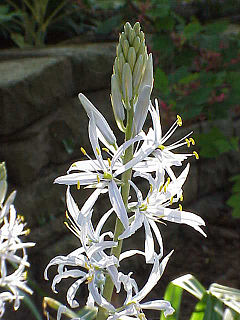|
Camassia Lindl es un género de plantas perennes y bulbosas pertenecientes a la antigua familia Agavaceae ahora subfamilia Agavoideae de las monocotiledóneas. Anteriormente se lo ubicaba dentro de la familia Liliaceae pero los estudios del ADN han demostrado que pertenece a Asparagaceae. Comprende 6 especies originarias de América boreal.
Descripción
Son plantas herbáceas, perennes y bulbosas, de hojas lineales y arrosetadas.
Las flores son actinomorfas o zigomorfas y hermafroditas, azules, purpúreas, blancas o amarillentas, pediceladas, dispuestas en racimos en la extremidad de un largo escapo bracteado. El perigonio está compuesto de 6 tépalos libres y extendidos. El androceo está formado por 6 estambres, insertos en la base de los tépalos. Los filamentos son filiformes y las anteras son dorsifijas. El ovario es súpero, trilocular y con los lóculos pluriovulados. El estilo es filiforme y el estigma es trífido. El fruto es una cápsula dehiscente.
Taxonomía
El género fue descrito por John Lindley y publicado en Edwards's Botanical Register 18: pl. 1486. 1832.[2] La especie tipo es: Camassia esculenta Lindl.
Especies
Referencias
Bibliografía
- Brisland, Richard T. W. Camas processing or upland hunting : an interpretation of lithic scatters at High Prairie. Calgary, Alb.: University of Calgary, 1992. Thesis (M.A.)
- Comber, Harold F.; Miller, Murray. Check list of the plants of the Camassia Natural Area : vascular plants. [Oregon]: Oregon Chapter, The Nature Conservancy, 1967
- Coville, Frederick V. The technical name of the camas plant. Proceedings of the Biological Society of Washington; v. 11 (1897), p. 61-65.
- Gould, Frank W. A systematic treatment of the genus Camassia Lindl. Notre Dame, Ind.: University Press, 1942.
- Konlande, J. E.; Robson, John R. The nutritive value of cooked camas as consumed by Flathead Indians. Ecology of food and nutrition, v.2, (1972), p.193-195.
- Maclay, Anne M. Studies of the life history of Camassia quamash (Pursh) Greene. Pullman, Wash. : State College of Washington (Washington State University), 1928. Thesis (M.S.)
- Rice, Peter M.; Toney, J. Chris.; Cross, Marcia Pablo. Rehabilitation of camas and bitterroot gathering sites: study plan. [Hamilton, Mont: Bitterroot National Forest: U.S. Forest Service], 1996.
- Smith, Harriet L. Camas: the plant that caused wars. Lake Oswego, Or.: Smith, Smith and Smith Pub. Co., 1978.
- Statham, Dawn Stram. Camas and the Northern Shoshoni: a biogeographic and socioeconomic analysis. Boise, Idaho: Boise State University, 1982.
- Thoms, Alston V. The northern roots of hunter-gatherer intensification: camas and the Pacific Northwest. Pullman, Wash.: Thesis (Ph. D.)--Washington State University, 1989.
- Toney, J. Chris. Traditional plant restoration: restoration of camas & bitterroot gathering sites (phase I-year 1 progress report). [Hamilton, Mont: Bitterroot National Forest: U.S. Forest Service], 1997
Enlaces externos
Proyectos de Conservación y Restauración
|
